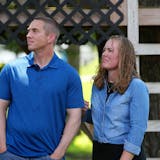Some years ago, I had breakfast with Gay Talese. Well, that's not precisely true: I had breakfast in the vicinity of Gay Talese. We were both speaking at a narrative nonfiction writing conference (he was the keynote; I was several rungs lower), and one morning I sat down in a nook in the hotel lobby to eat my fruit and yogurt. Talese sat down in the same nook.
I don't remember him eating anything; he looked like someone who lived on air, or nectar. He was tiny, smaller than me, and exquisite, and I was afraid to speak in case he might startle and flutter off, like a hummingbird or a butterfly.
Last week, he spoke at another narrative conference, and nobody is calling him exquisite after what he said there. I was not there, but I have read (all over the Internet) that he was asked which women writers had inspired him. Talese said that, outside of Mary McCarthy, he couldn't think of any.
Later, after Twitter exploded, he said he had misunderstood the question; he thought of inspiring him as meaning years ago, when he was starting out.
He told the New York Times, "I was giving an honest answer. I wasn't going to be influenced by anybody at age 56 or 70 or 84. … I'm talking about my formative years."
In his formative years, he said, he was influenced by sportswriters, especially Red Smith.
"When I was in my formative years, there were no women in journalism who inspired me," he said. "The women who inspired me were fiction writers."
Of course there were tons of women journalists back then, including intrepid war correspondents, and that explanation wasn't good enough for a lot of people. The hashtag #womengaytalese shouldread was born. All kinds of names have since been thrown out — Susan Orlean! Janet Malcolm! Joan Didion! — as possible sources of inspiration. (Some, while great, seem off-point — Charlotte Bronte? Patricia Highsmith?)



